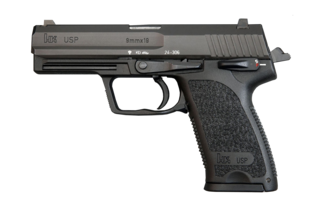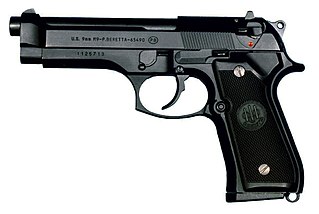Related Research Articles

The M1911, also known as Colt 1911 or Colt Government, is a single-action, recoil-operated, semi-automatic pistol chambered for the .45 ACP cartridge. The pistol's formal U.S. military designation as of 1940 was Automatic Pistol, Caliber .45, M1911 for the original model adopted in March 1911, and Automatic Pistol, Caliber .45, M1911A1 for the improved M1911A1 model which entered service in 1926. The designation changed to Pistol, Caliber .45, Automatic, M1911A1 in the Vietnam War era.

A derringer is a small handgun that is neither a revolver nor a semi/fully automatic pistol. It is not to be confused with mini-revolvers or pocket pistols, although some later derringers were manufactured with the pepperbox configuration. The modern derringer is often multi-barreled, and is generally the smallest usable handgun of any given caliber and barrel length due to the lack of a moving action, which takes up more space behind the barrel. It is frequently used by women because it is easily concealable in a purse or a stocking.

The Heckler & Koch MP7 is a personal defense weapon chambered for the HK 4.6×30mm armor-piercing cartridge designed by German defence manufacturer Heckler & Koch.

A semi-automatic pistol is a type of repeating single-chamber handgun (pistol) that automatically cycles its action to insert the subsequent cartridge into the chamber (self-loading), but requires manual actuation of the trigger to actually discharge the following shot. As a result, only one round of ammunition is fired each time the trigger is pulled, as the pistol's fire control group disconnects the trigger mechanism from the firing pin/striker until the trigger has been released and reset.

The .45 ACP or .45 Auto (11.43×23mm) is a rimless straight-walled handgun cartridge designed by John Moses Browning in 1904, for use in his prototype Colt semi-automatic pistol. After successful military trials, it was adopted as the standard chambering for Colt's M1911 pistol. The round was developed due to a lack of stopping power experienced in the Moro Rebellion in places like Sulu. The issued ammunition, .38 Long Colt had proved inadequate, motivating the search for a better cartridge. This experience and the Thompson–LaGarde Tests of 1904 led the Army and the Cavalry to decide that a minimum of .45 caliber was required in a new handgun.

The .380 ACP (9×17mm) is a rimless, straight-walled pistol cartridge developed by firearms designer John Moses Browning. The cartridge headspaces on the mouth of the case. It was introduced in 1908 by Colt, for use in its new Colt Model 1908 pocket hammerless semi-automatic, and has been a popular self-defense cartridge ever since, seeing wide use in numerous handguns. Other names for .380 ACP include .380 Auto, 9×17mm, 9mm Browning, 9mm Corto, 9mm Kurz, 9mm Short, and 9mm Browning Court. It should not be confused with .38 ACP. The .380 ACP does not strictly conform to cartridge naming conventions, named after the diameter of the bullet, as the actual bullet diameter of the .380 ACP is .355 inches.

The Heckler & Koch MK 23, MK 23 MOD 0, Mark 23, or USSOCOM MARK 23 is a semi-automatic large-frame pistol chambered in .45 ACP, designed specifically to be an offensive pistol. The USSOCOM version of the MK23 came paired with a laser aiming module (LAM) and suppressor. The USSOCOM MK23 was adopted by the United States Special Operations Command (USSOCOM) for special operations units, beating out the nearest competitor, Colt's OHWS. Development of the pistol began in 1991 as special operations representatives identified the need for an "Offensive Handgun Weapons System—Special Operations Peculiar", and delivery of the pistols began in May 1996 to the special operation units.

The SIG Sauer P220 is a semi-automatic pistol. Designed in 1975 by the SIG Arms AG division of Schweizerische Industrie Gesellschaft, and produced by J. P. Sauer & Sohn, in Eckernförde; it is currently manufactured by both SIG Sauer companies: SIG Sauer GMBH, of Eckernförde, Germany; and SIG Sauer, Inc., of New Hampshire, United States.
Blowback is a system of operation for self-loading firearms that obtains energy from the motion of the cartridge case as it is pushed to the rear by expanding gas created by the ignition of the propellant charge.

The USP is a semi-automatic pistol developed in Germany by Heckler & Koch GmbH (H&K) as a replacement for the P7 series of handguns.

The Heckler & KochP7 is a German 9×19mm semi-automatic pistol designed by Helmut Weldle and produced from 1979 to 2008 by Heckler & Koch GmbH (H&K). It was revealed to the public for the first time in 1976 as the PSP. The P7M13, a variant of the P7 with a double-stack magazine, was produced until 2000, and was unsuccessfully submitted to the U.S. Army XM9 pistol trials as a replacement for the M1911 pistol.

The Hi-Point Model JHP is a polymer-framed, semi-automatic, blowback-operated pistol manufactured by Hi-Point Firearms.

Star Bonifacio Echeverria, S.A. was a manufacturer of small arms in the Basque region of Spain from about 1905 until 1997.

The Joint Service Small Arms Program, abbreviated JSSAP, was created to coordinate weapon standardization between the various United States armed service branches.

The Colt Model 1900 is a short-recoil operated "self-loading", or semi-automatic .38 caliber handgun introduced by Colt's Manufacturing Company at the turn of the 20th century. It also marked the introduction of .38 ACP, the round for which it is chambered, and was the first handgun to utilize short-recoil operation.

The Hi-Point Model JCP is a blowback operated semi-automatic pistol chambered for the .40 S&W round.

The Heckler & Koch HK45 is a semi-automatic pistol designed by the German arms manufacturer Heckler & Koch.

A handgun is a short-barrelled firearm designed to be held and used with one hand. The two most common handgun sub-types in use today are revolvers and semi-automatic pistols, although other handgun-types such as derringers and machine pistols also see infrequent usage.
Llama Firearms, officially known as Llama-Gabilondo y Cia SA, was a Spanish arms company founded in 1904 under the name Gabilondo and Urresti. Its headquarters were in Eibar in the Basque Country, Spain, but they also had workshops during different times in Elgoibar and Vitoria. The company manufactured moderate-priced revolvers and self-chambering pistols in a wide variety of models. These were popular mainly in the European and Latin American export market, as well as domestically in Spain.
The .45 Super is a powerful smokeless powder center fire metallic firearm cartridge developed in 1988 by Dean Grennell, a well-known writer in the firearms field as well as managing editor of Gun World magazine. It is dimensionally similar to the .45 ACP round but has a thicker case wall and is loaded to higher pressures, which offers an average 300 feet per second (91 m/s) improvement in muzzle velocity over the .45 ACP. The cartridge was co-developed by Tom Fergerson and Ace Hindman.
References
- ↑ "Best Handguns That Never Were".
- ↑ "Modern Firearms - Colt SOCOM pistol". Archived from the original on 2014-04-15. Retrieved 2014-04-14.
